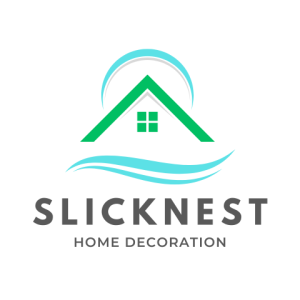Modern residences have changed into multi-functional areas that not only provide a living environment but also a spa-like wellness. The most visible change in this trend is bathroom design, where the once strict hygienic areas are now being changed into wellness promoting retreats bringing about relaxation and self-care.
A bathroom with a spa touch has, in fact, altered the way homeowners think about these spaces—they are no longer just functional needs but, in fact, essential havens for the rejuvenation of the mind and body.
This transformation is aligned with the needs of a society that is getting more and more fast-paced where the chances to really relax are getting fewer and fewer, thus making them very much sought after.
The inclusion of certain elements such as rain showers, steam systems, free-standing tubs, aromatherapy, and neutral color schemes has been the main point of this revolutionary way of transforming bathroom design.
Spa-Like Wellness Retreats in Modern Bathroom Design
This article will discuss all these major components, looking at their separate advantages, their combined effect when partnered, and the main reasons for their increased acceptance within the field of modern interior design.
1 Rainfall Showers.
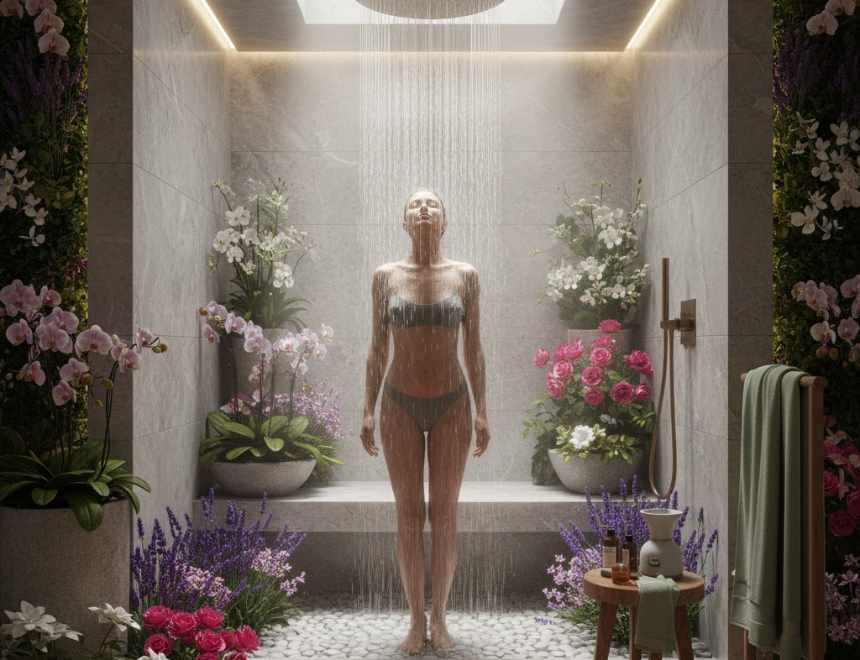
The rainfall shower is trending as a necessary feature in modern bathtub design, generating a big change in perception and thus, in the daily routine.
People using regular showers get water in a concentrated spray while the water from the nose of the rain shower gets dispersed through a majestic large diameter and unique pattern that imitates the soft, all-over, and gentle feeling of a natural rain.
Ordinary showers typically give the same feeling as a gentle rain through a higher percentage of 2 gallons/min. Or more through their misty heads. That is, water spread all over the body; thus, the user feels them
They can even sink deeply into meditative mode when they are not being directly calmed or energized, as they get the spa treatment of the luxuriously high-class ones right in their homes.
Rainfall showers installation involves proper fixture selection but also one more consideration planned taking into account sensory aspects to be maximized. Taking into account the human factor, the most appropriate place for mounting is ceiling mounting right above at a right angle, which makes sure hot water gets evenly distributed over the body
. Experts recommend going for a showerhead with a minimum diameter of 10 inches. Even bigger sizes give the option of being stepped further into the water and making a real bathing place with a huge garden of colorful and scented flowers around you.
More and more consumers opt for hight-adjustable arm systems which allow for water direction control, and then they can set the water flow angle according to their preferences.
The flexibility of this arrangement will not just serve their individual purposes but also those of various family members and will even switch from one extreme of therapy- vigorous morning wakeups to gentle evening retreats – to another as needed.
Total-Body Coverage: The large area of rain showerheads gives the opportunity to have a full body soak simultaneously, thus providing a uniform soaking experience unlike that of regular showerheads.
This covering of whole body area makes it unnecessary to keep moving under the water stream all the time, thus delivering a more watery and mellow therapy treatment. This feature makes it possible to have basic hygiene as a personal wellness practice.
Also Read; Maximize Your Mini Bathroom: Clever Remodeling Tips & Stylish Designs
2 Steam Systems

The union of steam systems is a significant element in the bathroom design that focuses on wellness, as it guarantees a wide range of health benefits that are well documented and go beyond just relaxing the mind.
Nowadays, the residential steam units can easily be added to the existing shower cabins without being noticeable, and only a sealed space plus a steam generator is needed to provide a personal steam room experience.
The healing properties of steam have been acknowledged by different tribes and cultures throughout history, but the public had to wait until recently when technological innovations brought these benefits to residential private places.
The basis of steam therapy is to create a moist heat with a temperature of about 115°F to 120°F/46°C to 49°C and that will bring about the physiological reactions which help both physical and mental wellness.
Among the benefits of steam therapy, probably the most immediate and noticeable ones concern the respiratory function. The warm and moist air works like a miracle in opening up nostrils and promoting the drainage of the sinuses, soothing the throat, and also acting as a natural expeller facilitating the loosening of the secretions in the bronchi.
Therein, apart from the respiratory benefits, steam therapy provides skin health much more than cleansing, it is like the opening of skin pores only when necessary, and subsequently, dead skin cells are removed and dry skin get more moisture, hence a healthier complexion is the result .
Another critical health benefit of steam is that circulation of blood gets profoundly impacted and the reason is that the heat causes blood vessels to open up; thus oxygen and nutrient supply is improved throughout the body while facilitating the elimination of metabolic waste products..
The steam systems’ mental and emotional benefits are alike, very remarkable and they confront many stress-related issues that are common in modern life:
Stress Reduction: Steam exposure has been proven to reduce cortisol levels which is the main hormone that the body releases in response to stress. This physiological change leads to a state of relaxation and emotional stability which is able to combat the daily pressures.
Modern steam systems can be upgraded with incorporated technologies that not only complement but also greatly extend their therapeutic possibilities.
More and more homeowners are now utilizing aromatherapy infusion systems that vaporize essential oils together with steam, creating an experience that appeals to another sense.
In a similar way, chromotherapy (color therapy) lighting systems can be set up in steam rooms, where colored light is used to affect mood and add to the overall atmosphere.
These technological integrations convert the mere steam therapy into a multi-sensory wellness experience that caters to both the physical and psychological needs.
Also Read; 10 Innovative Small Bathroom Storage Ideas
3 Freestanding Tubs

Freestanding bathtubs are designed to be both functional and visually striking, making them perfect for a wellness-oriented bathroom, and they can create an immediate visual impact that makes the space a dedicated retreat.
Freestanding tubs are more than built-in models since they give a great deal of design freedom in the aspect of placement and thus can be put as the room’s focal point—often with a view, right in the middle of the room, or even under a window to catch the most natural light.
Such positioning empowers homeowners to design bathing spaces that are truly personal according to their relaxation rituals. The aesthetic factor of freestanding tubs is not just limited to their shape but also the materials they are made of, ranging from the classical cast iron to the more contemporary acrylics and composites, giving the users distinct touch and temperature sensations which ultimately amplify the experience of bathing.
The different types of bath tubs that are present in the market today will meet not only the beauty needs but also the user’s requirements for their functionality.
Soft, flowing lines that imitate the shapes found in nature are among the characteristics of the organic forms that today we find widely used in the design of bathrooms because spa-like bathrooms not only look good but at the same time, they bring nature closer and thus, wellness through the connection to nature is emphasized.
Sculptural designs like this one often reference traditional Japanese soaking tubs or classic European clawfoot bathtubs, where the line and proportion have been made more modernized.
On the other hand, ergonomic advantages are a big plus and one such feature is that many models have reclining backs, armrests, and extra depths that support reclined, immersed bathing and so on which are all characteristics of comfortable, luxurious, and relaxing bathing positions.
Such a considerate design approach turns practical bathing into an extravagant experience that invites prolonged relaxation and stress release.
Freestanding tubs have various pros beyond their main functional and aesthetic aspects, and one of the most important ways is the impact they have on the overall spatial dynamics of the bathroom:
Visual Spaciousness: By not being placed against walls, freestanding tubs allow the bathroom space to flow freely and this, in turn, gives the whole bathroom a larger and more open feel.
The effect of this perceived expansion is an increase of the essential feeling of freedom and luxury that is characteristic of the spa experience.
Also Read; 5 Budget-Friendly Small Bathroom Ideas
4 Aromatherapy
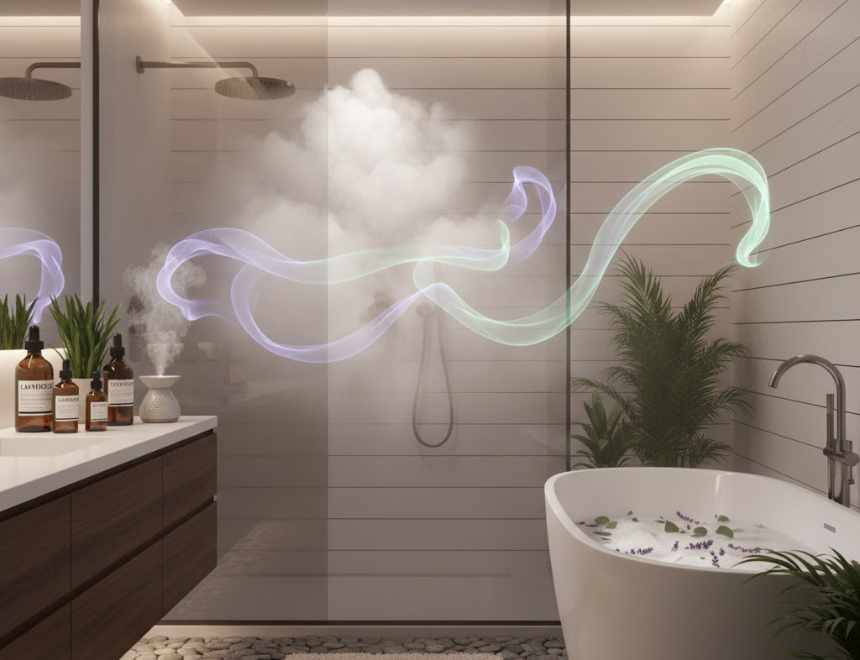
Aromatherapy is the invisible but great dimension of spa-like bathroom design, which uses the olfactory sense to both psychological and physiological states.
Essential oils from plants, such as lavender, eucalyptus, citrus, and jasmine, can be though of as the naturals techniques for cleansing and refreshing the body and spirit that transcend the ordinary bathing ritual—each practicing according to the specific ground from stress relief to energy increase.
The bathroom is the perfect place for the use of essential oils, as there is steam from showers and baths which boosts the dispersion of oil molecules and that makes them inhale and absorb more.
This interdependent partnership created by water, heat, and essential oils brings about a total sensory environment which not only makes the ritual easier but also more effective.
The ways in which aromatherapy was practiced in the bathroom have come a long way which now gives the homeowners the freedom to choose the most convenient method to be adapted to their particular taste and the bathroom layout.
For instance, one option available for people who own bathtubs is the classic and most straightforward approach consisting of pouring a few drops of essential oils blended with a carrier substance (e.g. almond oil, coconut oil, or honey) into the bathtub creating a hydro-aromatherapy just for you.
The users of showers, on the other hand, can choose from a number of efficient methods such as: putting a few drops of oil on the shower floor where the water will cause it to evaporate, using special shower discs or stones for aromatherapy that release their scent slowly, or making a simple shower spray by mixing water with essential oils in a spray bottle for spraying shower walls.
Such approaches guarantee that even the fastest showers can turn into moments of getting fragrant indulgence. Properly chosen essential oils give homeowners the opportunity to tailor their health experience according to the result they desire:
Relaxation and Sleep Support: Lavender, chamomile, and bergamot are among the essential oils which are it is praised for their calming effects and thus are the best choice for night bathing ceremonies that aim at alleviating stress and getting the body ready for a peaceful night of sleep.
The latest bathroom trends offer integrated aromatherapy systems along with other wellness features as a combined package. Automatic aromatherapy dispensers that inject essential oils into the steam at a preset amount and thus, are able to disperse the oils evenly are already a part of some high-end steam shower systems.
Dedicated diffusers for essential oils that are made exclusively for bathrooms can also be employed to continuously spread the pleasant smell without the necessity of applying the oils directly to water or surfaces.
Such tech-savvy solutions are the next big thing in aromatic wellness, since they offer a very precise control over the intensity and the duration of fragrance that create specially tuned ambient conditions.
Also Read; 32 Beautiful Bathroom Tile Design Ideas
5 Neutral Palettes
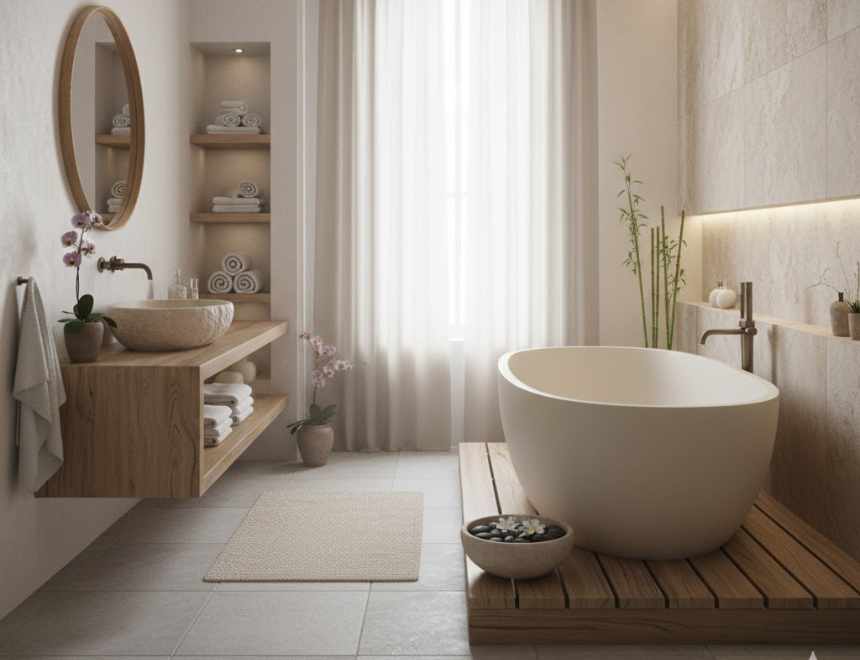
The choice of neutral hues in bathrooms with a spa-like atmosphere is not only a matter of taste but also a strategy based on the psychological effects of colors and their impact on human feelings and mental states.
Neutral colors, such as soft whites, gentle grays, warm beiges, and earthy taupes, build up a visually soothing atmosphere that is directly connected to the main use of the bathroom as a place for relaxation and rejuvenation
. By promoting mental calmness and emotional stability, neutral colors do so through decreasing visual noise and sensory overload, which also applies to the nervous system.
Hence, this peacefulness is at the very heart of a wellness retreat, where the idea is to create a disconnect from the over-stimulation of everyday life and foster an atmosphere apt for reflection and renewal.
- The psychological influence of certain neutral colors is not limited to universal calming of the whole area but rather involves subtle emotional reactions that could be utilized wisely in the design of the bathroom. For example, soft blues remind of the sky and water, thus decreasing stress and increasing calmness.
- Light greens signify balance, serenity, and rejuvenation, which is why they are most suitable when aiming to have nature brought into the bathroom . Light grays and warm beiges offer an elegant, stable background that fortifies feelings of security and longevity.
- In this way, with careful planning, these different neutral tones can tell a sophisticated color story that not only supports various facets of wellness but also does so quietly without visual agitation or startling contrasts that might interrupt the peaceful atmosphere.
- The bathroom design functional advantages of neutral palettes, besides the fact that they are easier to work with, come in very handy. They are perceived to be spatially more and more comfortable to the eye:
Spatial Enhancement: Soft whites and pale grays seen through light-reflecting neutrals increase the visual area of small rooms and thus bathrooms can be made to feel more open and airy, which is a desirable feature for urban living especially when floor space is low.
It is the usage of neutral palettes in the contemporary bathroom design, together with natural materials, which has been the trend. A combination of different materials does not only create a sensory environment but also involves all the senses at once.
Besides, the mixing of matte with glossy finishes, smooth with rough tiles, cool marbles with warm woods is visually appealing but does not disturb the calmness of the area.
This material selection based on the neutral color range creates a rich tactile experience which in turn suggests higher quality and luxury—primary factors in creating a bathroom that feels like a special retreat rather than just an everyday functional space.
The outcome of this design is a multisensory relaxation zone where the welfare of the user is secured through both visual and physical comfort.
Also Read; 10 Luxurious Wall Decor Ideas to Elevate Your Home
6 Integration and Implementation
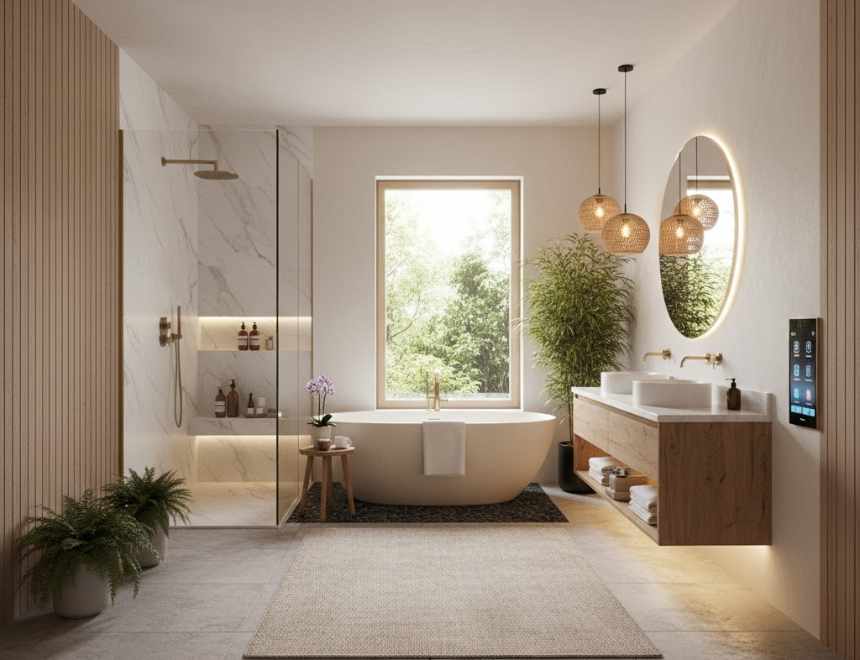
The successful creation of a spa-like bathroom retreat does not rely solely on the incorporation of the individual wellness elements but rather on the thoughtful integration of these elements into a cohesive and harmonious environment that must serve both functional and aesthetic purposes.
This holistic approach necessitates the meticulous planning that takes into account how each and every single component—from the practical to the perceptual—interacts with and enhances the others.
The core aim is to fashion a setting that gives the impression of being purposely made for wellness instead of just being put together with the fashionable features of the day.
This difference is made by the painstaking detail and the deliberate creation of sensory experiences that support relaxation and rejuvenation through their combined efforts.
The bathroom designers often take the integration of this kind of approach through the sequence of experiences, sight lines, and the contribution of each element to the overall atmosphere.
The practical execution of a bathroom that is wellness-focused entails not only the strategic consideration of all the factors involved but also a lot of the aspects that come through from both the design process and the end-user experience.
Space planning must find a way to house the desire for the different features with the need for the comfortable and less intrusive visual movements—even in the smaller bathrooms, where a right layout can create different wellness activity areas without compromising on the feeling of spaciousness.
- Lighting is a crucial aspect that must be considered in the bathroom design process. The lighting design must be given special consideration, layered approaches must include general illumination or ambient lighting, practical activities or task lighting, and architectural features or mood lighting as the main types of lighting in the bathroom—all with dimming features so that the brightness can be adjusted according to the time of the day and the wanted atmosphere.
. When it comes to the selection of materials, their sensory attractiveness and easy maintenance should be taken into account. Select the surfaces that are pleasant to touch and at the same time resist moisture and frequent cleaning.
In addition to these primary wellness features that have been previously mentioned, there are several supporting elements which are likely to play a significant role in spa-like experience:
Smart Technology Integration: Digital controls come into play and allow precise management of different wellness systems—their range stretches from steam generators and multi-spray showers to lighting and sound systems.
This tech integration gives the user the power to not only create but also to store various presets for different wellness scenarios, so they can have the same experience every time with just a little change for each use.
Careful planning is required in the implementation process itself, especially when it comes to incorporating complex systems like steam generators or custom shower installations that may need more plumbing, electrical, or structural work done.
This is where the engaging professional designers and contractors who have experience in wellness-focused bathrooms can help homeowners navigate through the technical requirements and not end up with potential setbacks.
Investing in the right installation guarantees not just the best working condition of the individual features but their reliability and satisfaction in the long run, too.
Additionally, it is necessary to consider the timing of renovations when thinking about the creation of a spa-like bathroom, as some elements might have to be coordinated in a specific order—for instance, steam system components should be installed during rough-in phases before finishing materials are applied.
This disciplined approach to implementation will not only lead to the desired result—a home wellness sanctuary that integrates seamlessly and is truly transformative.
Also Read; Transformative Interior Design Trends in the USA
Conclusion
The transformation of traditional bathrooms into spa-like wellness havens reflects a shift in the perception of these areas, with self-care being acknowledged as a necessity for health.
Rain showers, steam systems, and soaking tubs, to name a few, are all part of the installation that creates an environment of peace that is very effective in tackling the stress caused by the fast-paced modern life.
The trend that is emerging is a reflection of the need for private havens, thus the future advancements are likely to be about smart technology and Eco-friendly materials which will allow for personalized experiences.
This transition assigns a different role to the bathrooms as they become more than just functional spaces, but rather, indispensable sanctuaries that nurture the good through better sleep and rejuvenated vigor thus encouraging one to adopt self-care as a practice.
Recent Posts
Maximize Your Mini Bathroom: Clever Remodeling Tips & Stylish Designs
In the domain of home design, the mini bathroom has always been regarded as a problem—a space that is small and functional only with minimum potential. This notion, however, is ignoring a...
Cluttered, small bathroom is not a rare thing and it is a common frustration of many homeowners. With the rising trend of more people searching for space-saving solutions like the "Slimline Toilet,"...
